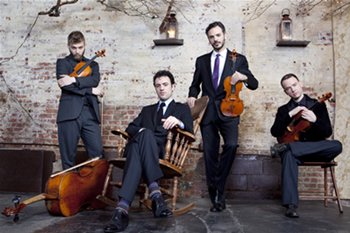The weather can wreak havoc on the normal flow of our lives; it is no different for the musicians who play in symphony orchestras. The Winston-Salem Symphony had a couple of rehearsals last week, but had to cancel the Saturday and Sunday concerts scheduled at the Stevens Center because of the snow storm. Nonetheless, the orchestra gathered on Tuesday night to present solid performances of three works for a good-sized audience that was willing to brave the elements.
The evening opened with the Fifth Symphony by Jean Sibelius (1865-1957), which was commissioned by the Finnish government on the occasion of his 50th birthday in 1915. Sibelius conducted the premiere that year, but subsequently revised the symphony into a three-movement work, resulting in the 1919 version that is most often performed.
The opening movement begins with a spacious soundscape erected by brass and winds that evokes both grandeur and mystery. WSS played with sensitivity and power both here and throughout the evening.
The second movement features a five-note motive that permeates the entire texture – strings, winds and brass – cleanly articulated by all. The finale begins with a whirlwind of activity to finally arrive at the most famous tune of the piece, supposedly inspired by the composer witnessing 16 swans taking flight all at once. The entire work ends enigmatically with six isolated and staggered chords.
Music Director Robert Moody led the ensemble with his usual animated and sensitive conducting. Throughout the evening, commentary (often mirroring the fine notes by David B. Levy in the program) and pictures were projected onto a screen hanging above the orchestra.
D.J. Sparr (b. 1975) was both composer and soloist in the 16-minute Violet Bond: Concerto for Electric Guitar, a three-movement work with no break between the sections. The piece utilizes several electronic “tricks” (such as a “loop effect,” which allows the guitarist to record a short passage and repeat it, all the while playing over it). I think the most attractive aspect of the work is the use of innumerable textures evoked by the electric guitar and orchestra. Often these reflected influences such as Steve Reich and Debussy – lovely and shimmering.
The main idea of much of the work was the opening arpeggiated figure presented by the guitar. Improvisation by the guitarist was featured in several passages, while the orchestra repeated melodic fragments (much like the looping technique) until Sparr signaled Moody it was time to move on. Toward the end, a chorale-like passage recalled the composer’s grandmother Violet Bond playing hymns on the piano.
Antonín Dvořák (1841-1904) lived in New York City from 1892-95, serving as director of the National Conservatory of Music. During this time, he was commissioned by the NY Philharmonic to write a symphony; the result was the composer’s most loved work, Symphony No. 9 “From the New World.” The piece is in the traditional four movements.
This is a mighty work that is chockful of tunes derived from the United States (albeit with a Bohemian accent), including Native American and African-American influences. Indeed, the composer urged American composers to quit trying to sound like their European counterparts and develop a nationalistic style that incorporated American folk music.
The energy Moody brought to the piece was terrific, although I thought the opening introduction to be a bit slow. Once again the brass section got to strut its stuff, with hearty writing for both solo and ensemble. The strings had their work cut out for them, playing both delicate, wistful passages as well as continuous sawing. Occasionally, the brass and woodwinds (here and in the Sibelius) overpowered the strings.
The second movement Largo, with its opening haunting brass evocation and lovely English horn solo (played by John Hammarback), was beautiful. The third movement, which incorporates Native American influences, was a blast. The finale incorporates snippets of earlier movements and was a tour-de-force for all members of the orchestra. The galloping conclusion delighted the audience, which leapt to its feet in appreciation.
A word about the running commentary that took place throughout the performance on the screen; I would guess that there are both supporters and detractors. On the positive side were pictures and comments that deepened the listeners’ understanding of the work (formal considerations or quotes from composers). On the other side, the projections could be distracting, and the subjective verbiage and the duplication of thoughts already presented in the program notes might have been unnecessary.












